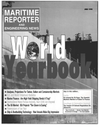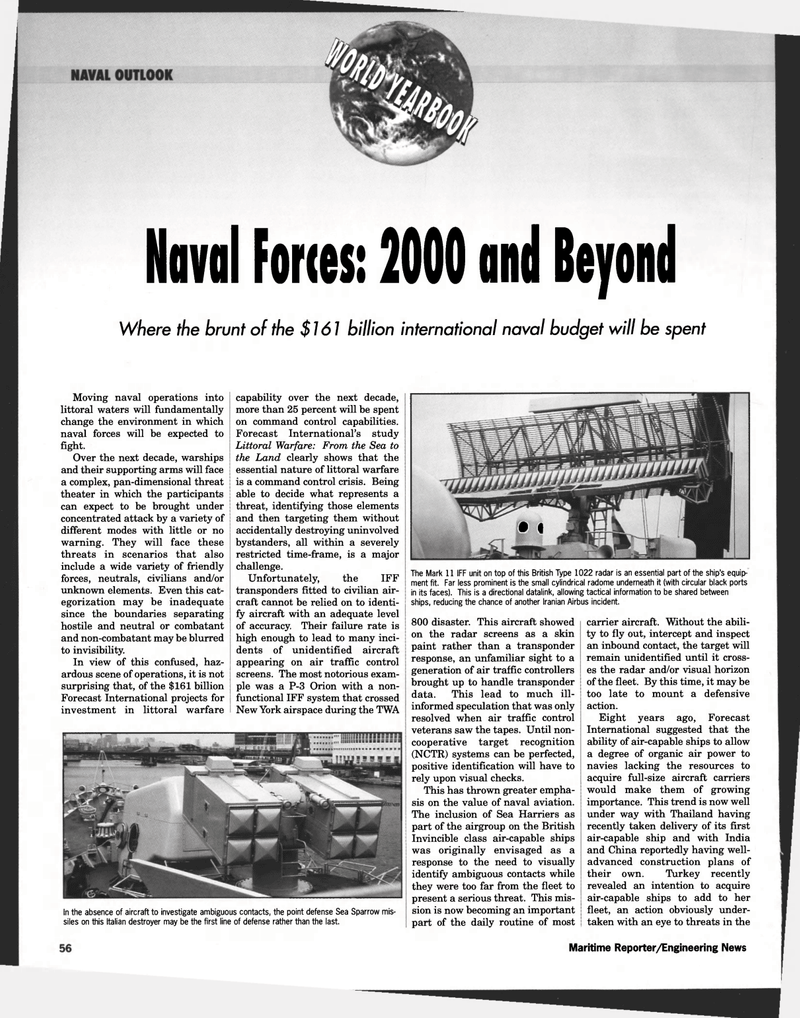
Page 85: of Maritime Reporter Magazine (June 1998)
Read this page in Pdf, Flash or Html5 edition of June 1998 Maritime Reporter Magazine
Naval Forces: 2000 and Beyond
Where the brunt of the $161 billion international naval budget will be spent
The Mark 11 IFF unit on top of this British Type 1022 radar is an essential part of the ship's equip- ment fit. Far less prominent is the small cylindrical radome underneath it (with circular black ports in its faces). This is a directional datalink, allowing tactical information to be shared between ships, reducing the chance of another Iranian Airbus incident.
Moving naval operations into littoral waters will fundamentally change the environment in which naval forces will be expected to fight.
Over the next decade, warships and their supporting arms will face a complex, pan-dimensional threat theater in which the participants can expect to be brought under concentrated attack by a variety of different modes with little or no warning. They will face these threats in scenarios that also include a wide variety of friendly forces, neutrals, civilians and/or unknown elements. Even this cat- egorization may be inadequate since the boundaries separating hostile and neutral or combatant and non-combatant may be blurred to invisibility.
In view of this confused, haz- ardous scene of operations, it is not surprising that, of the $161 billion
Forecast International projects for investment in littoral warfare capability over the next decade, more than 25 percent will be spent on command control capabilities.
Forecast International's study
Littoral Warfare: From the Sea to the Land clearly shows that the essential nature of littoral warfare is a command control crisis. Being able to decide what represents a threat, identifying those elements and then targeting them without accidentally destroying uninvolved bystanders, all within a severely restricted time-frame, is a major challenge.
Unfortunately, the IFF transponders fitted to civilian air- craft cannot be relied on to identi- fy aircraft with an adequate level of accuracy. Their failure rate is high enough to lead to many inci- dents of unidentified aircraft appearing on air traffic control screens. The most notorious exam- ple was a P-3 Orion with a non- functional IFF system that crossed
New York airspace during the TWA • I 800 disaster. This aircraft showed on the radar screens as a skin paint rather than a transponder response, an unfamiliar sight to a generation of air traffic controllers brought up to handle transponder data. This lead to much ill- informed speculation that was only resolved when air traffic control veterans saw the tapes. Until non- cooperative target recognition (NCTR) systems can be perfected, positive identification will have to rely upon visual checks.
This has thrown greater empha- sis on the value of naval aviation.
The inclusion of Sea Harriers as part of the airgroup on the British
Invincible class air-capable ships was originally envisaged as a response to the need to visually identify ambiguous contacts while they were too far from the fleet to present a serious threat. This mis- sion is now becoming an important part of the daily routine of most carrier aircraft. Without the abili- ty to fly out, intercept and inspect an inbound contact, the target will remain unidentified until it cross- es the radar and/or visual horizon of the fleet. By this time, it may be too late to mount a defensive action.
Eight years ago, Forecast
International suggested that the ability of air-capable ships to allow a degree of organic air power to navies lacking the resources to acquire full-size aircraft carriers would make them of growing importance. This trend is now well under way with Thailand having recently taken delivery of its first air-capable ship and with India and China reportedly having well- advanced construction plans of their own. Turkey recently revealed an intention to acquire air-capable ships to add to her fleet, an action obviously under- taken with an eye to threats in the In the absence of aircraft to investigate ambiguous contacts, the point defense Sea Sparrow mis-siles on this Italian destroyer may be the first line of defense rather than the last. 87 Maritime Reporter/Engineering News

 84
84

 86
86
